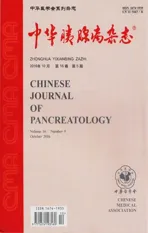自噬与急性胰腺炎研究现况
2016-01-25余巧,韩超群,丁霏霏等
自噬与急性胰腺炎研究现况
余巧 韩超群 丁霏霏 丁震
急性胰腺炎(AP)是胰酶异常激活的“自身消化”性炎性疾病,死亡率为4%~15%,在重症患者中高达15%~90%[1]。胰酶在胰腺腺泡细胞内的激活一直被认为是AP发病早期的主要病理事件,但AP的发病机制目前尚不清楚。正常情况下,自噬能够保护机体抵御感染、老化、肿瘤等各种病理状态,是真核细胞长期存活所必需的。在某些情况下,自噬受损或被过度激活,其功能发生改变导致疾病的发生[2]。目前已有研究证实自噬参与AP的发生、发展过程[3],然而具体作用机制仍不明确。本文就自噬与AP研究新进展做一综述。
一、自噬过程
蛋白质降解主要依赖两种方式:泛素-蛋白酶体系统和自噬,前者主要负责降解短寿命蛋白质,而后者主要降解长寿命蛋白质和细胞器等成分[4]。自噬是通过溶酶体来降解细胞内大分子物质和一些受损细胞器等的过程。自噬分为大自噬、小自噬、分子伴侣介导的自噬,目前认为大自噬(即一般所说的自噬)与人类疾病关系最为密切。自噬过程首先是形成吞噬细胞内待降解物的杯型单层膜,然后头端封闭形成双层膜结构的自噬体,其外层膜再与溶酶体融合形成自噬溶酶体,最后通过溶酶体内的各种水解酶降解自噬溶酶体内的待降解物质。参与调节自噬过程的相关基因统一称为Atg(autophagy-related gene),Atg12-Atg5-Atg16L复合物定位于自噬体膜上,是自噬形成的关键物质[5-6]。自噬有许多正、负调节因子,例如:酵母Atg6的同系物(beclin1)可与Ⅲ型磷脂酰肌醇3-激酶(Class Ⅲ PI3K) 形成复合物而激发自噬;自噬体膜上的自噬相关标志物微管相关蛋白1轻链3(microtubule-associated protein 1 light chain 3,LC3)与自噬泡形成量成正相关[7-8]。TOR(target of rapamycin)能与配体形成TORC1(TOR complex 1)并通过磷酸化Atg13和ULK1(UNC-51 like kinase 1)、ULK2而抑制自噬[9-10]。再有研究表明,Rab7和溶酶体膜蛋白LAMP-2可能是自噬体膜与溶酶体膜融合必需的调控因子[11-12]。所以自噬是多种因子参与的过程,任何环节的调控受损都可以引起自噬过程受阻。
二、自噬与炎症反应
AP常常伴随着局部或系统性炎症反应。虽然腺泡细胞内胰蛋白酶原提前异常激活是AP的关键起始因子,并进一步导致“胰腺自身消化”,但胰蛋白酶原激活这一因素还不足以完全引起胰腺炎及其并发症。
在AP 中,胰腺受损的细胞会释放多种炎症趋化因子,进而趋化炎性细胞浸润[13]。正常自噬可通过抑制炎症小体(inflammasome)从而抑制炎症反应[14]。在AP发病过程中,炎症递质的上调扮演着重要角色,IL-1β能够增加腺泡细胞内质网压力引起高钙血症,通过诱导受损自噬来促进胰蛋白酶原激活和降低胰腺腺泡细胞活力[15-16]。还有研究发现,脂多糖(LPS)处理缺乏Atg16L的小鼠,其血清IL-1β 和 IL-18水平升高[17],证明AP中炎症因子的上调可能与受损自噬相关。
胰腺炎中NF-κB信号通路被激活后,可促使机体释放炎症趋化因子以及炎症因子TNF-α等,TNF-α又可以诱导胰蛋白酶原过早激活及腺泡细胞坏死,而激活的胰蛋白酶原可能进一步激活NF-κB信号通路,加重AP[18]。细胞内受损自噬底物p62/SQMTS1的聚集可促使依赖p62的NF-κB信号通路激活,但抑制NF-κB信号通路可减少急性坏死性胰腺炎(acute necrotizing pancreatitis,ANP)中LC3-Ⅱ和beclin 1的表达[19]。IκB激酶复合物(IKKs)是NF-κB信号通路的主要调节者,敲除IKK基因能够诱导AP的发生[20]。而有报道认为酶原激活与NF-κB信号通路可能是AP早期阶段两个独立事件,胰蛋白酶原可能无法激活NF-κB[21]。
在AP的早期阶段,氧化应激也发挥着重要作用。活性氧类(reactive oxygen species, ROS)能够促进胰腺腺泡细胞线粒体内细胞色素c的释放,从而促进细胞凋亡[16,22]。损伤的线粒体可被自噬途径降解,从而减轻细胞凋亡和坏死[11]。AP时,损伤的线粒体残留,导致ROS增加、炎症小体激活以及炎症小体降解不彻底等。此外,受损自噬可通过调节炎症小体依赖反应和炎症因子IL-1β和 IL-18的分泌来调控炎症反应[15,23-24]。正常自噬抑制炎症反应,受损自噬可通过促进炎症反应促使疾病发展,通过抑制自噬受损或减少自噬的过度激活可调控AP发展,甚至可能阻止AP中SIRS、MODS的发生。
三、自噬与胰蛋白酶原激活
AP患者腺泡细胞内胰蛋白酶原的激活一直被认为是AP的始动因素[25]。在AP模型中观察到早期损伤的胰腺腺泡细胞空泡内出现消化酶与溶酶体水解酶的共区域化,并证实溶酶体内的水解酶可激活胰蛋白酶原[26]。近年来,新的理论认为自噬可诱发或促进AP,尤其是通过激活细胞内胰蛋白酶原从而增加蛋白质降解,并进一步激活新的胰酶[3,21]。雨蛙素处理Atg5基因敲除小鼠后,AP病情严重程度减轻,腺泡内激活的胰蛋白酶原水平也下降,说明自噬可能通过激活胰蛋白酶原而在AP中发挥有害作用[27]。在不同的AP模型中,AP早期胰腺腺泡细胞内都可出现包含消化酶和溶酶体酶的液泡,这种液泡具有双层膜结构、LC3-Ⅱ标记阳性等多种自噬泡特征,这与AP早期非正常合成新的消化酶及溶酶体酶现象相符[8,28]。此外,也有研究发现,在雨蛙素诱导的AP模型中,可能存在两种不同的机制来介导胰蛋白酶原的激活,初期主要是由于雨蛙素促进溶酶体内组织蛋白酶B(cathepsin B,CTSB)前体的成熟,进而引起胰蛋白酶原向胰蛋白酶的转变;后一阶段,细胞内逐步形成包含有酶原颗粒的双层膜液泡,即自噬占主导作用[29]。同时,Hashimoto等[30]认为腺泡细胞内胰蛋白酶原可能是在自噬溶酶体内被CTSB水解为胰蛋白酶。然而,Wartmann等[31]研究发现,溶酶体内的组织蛋白酶L(cathepsin L,CTSL)可使胰蛋白酶原失活,并能够拮抗CTSB的功能。
综上研究认为,AP中受损自噬可促进胰蛋白酶原激活,主要是通过自噬溶酶体内的相关组织蛋白酶失调介导。AP过程中,溶酶体内的CTSB增多,促进胰蛋白酶原激活;CTSL减少及活性减弱导致自噬泡中胰蛋白酶原及胰蛋白酶降解受限,二者共同作用,导致胰蛋白酶原激活、胰蛋白酶聚集增多。
四、受损自噬与溶酶体功能障碍
自噬是溶酶体源性降解途径,多数研究认为自噬在AP过程中被激活但受损, AP发病早期出现的溶酶体功能障碍也被普遍接受,并认为AP中自噬受损可能与溶酶体功能障碍有关。mTORC1可负性调节自噬,而功能缺陷的溶酶体可通过抑制mTORC1活性而诱发自噬[32]。另有研究发现,mTORC1可能被由溶酶体内流入细胞质中的氨基酸激活,但溶酶体上具体氨基酸传感器尚不确定,迄今为止发现的第1个下游靶点是液泡型三磷酸腺苷酶H+-ATPase(V-ATPase),V-ATPase可通过增强GEF调节子的活性而激活Rag GTPases[33]。据此推测,涉及溶酶体Rag GTPases的某种氨基酸敏感途径可调节mTORC1,进而调节自噬过程[34]。
溶酶体相关膜蛋白(lysosome-associated membrane proteins, LAMPs)是一种高度糖基化的跨膜蛋白,维持溶酶体结构完整性及正常降解功能,在溶酶体内膜上形成保护性的被膜,使溶酶体内水解酶与细胞内其他物质及代谢途径相隔离,从而保护溶酶体膜及细胞质内其他物质不被水解[35]。在AP中溶酶体功能出现以下几种障碍:其一,溶酶体内组织蛋白酶的加工处理异常,即组织蛋白酶双链形式的成熟结构减少,未成熟结构聚集增多;其二,AP模型中,CTSB与CTSL激活及活性失调;其三,LAMP-1和LAMP-2显著减少,AP中组织蛋白酶的作用及其在溶酶体内的位置发生改变使得LAMP易于被降解[36]。
五、结语
综上所述,自噬是正常细胞的防御机制,而受损自噬则参与AP发生和发展,其可激活胰蛋白酶原,调节AP炎症反应,并与溶酶体功能障碍密切相关。AP目前仍是一种机制复杂、发病凶险、死亡率高的临床急症,临床治疗手段还未能完全阻止重症AP的发生、发展。因此,需要进一步明确AP中溶酶体功能障碍介导的自噬受损、受损自噬调节胰蛋白酶原激活及炎症反应潜在的机制,并尝试通过改善溶酶体功能、抑制自噬受损等手段制定出新的高效AP治疗策略。
[1] Hazra N, Gulliford M. Evaluating pancreatitis in primary care: a population-based cohort study[J]. Br J Gen Pract, 2014,64(622):e295-e301. DOI: 10.3399/bjgp14X679732.
[2] Levine B, Kroemer G. Autophagy in the pathogenesis of disease[J]. Cell, 2008,132(1):27-42. DOI: 10.1016/j.cell.2007.12.018.
[3] Zhang L, Zhang J, Shea K, et al. Autophagy in pancreatic acinar cells in caerulein-treated mice: immunolocalization of related proteins and their potential as markers of pancreatitis[J]. Toxicol Pathol, 2014, 42(2): 435-457. DOI: 10.1177/0192623313486967.
[4] Chen ZF, Li YB, Han JY, et al. The double-edged effect of autophagy in pancreatic beta cells and diabetes[J]. Autophagy, 2011,7(1):12-16. DOI: 10.4161/auto.7.1.13607.
[5] Sokollik C, Ang M, Jones NL. Autophagy: A primer for the gastroenterologist/hepatologist[J]. Can J Gastroenterol, 2011,25(12):667-674.
[6] Mehrpour M, Esclatine A, Beau I, et al. Autophagy in health and disease. 1. Regulation and significance of autophagy: an overview[J]. Am J Physiol Cell Physiol, 2010,298(4):C776-C785. DOI: 10.1152/ajpcell.00507.2009.
[7] Valente G, Morani F, Nicotra G, et al. Expression and clinical significance of the autophagy proteins BECLIN 1 and LC3 in ovarian cancer[J]. Biomed Res Int, 2014,2014:462658. DOI:10.1155/2014/462658.
[8] Czaja MJ. Functions of autophagy in hepatic and pancreatic physiology and disease[J]. Gastroenterology, 2011,140(7):1895-1908. DOI:10.1053/j.gastro.2011.04.038.
[9] Alers S, Loffler AS, Wesselborg S, et al. Role of AMPK-mTOR-Ulk1/2 in the regulation of autophagy: cross talk, shortcuts, and feedbacks[J]. Mol Cell Biol, 2012,32(1):2-11. DOI: 10.1128/MCB.06159-11.
[10] Jung CH, Ro SH, Cao J, et al. mTOR regulation of autophagy[J]. FEBS Lett, 2010,584(7):1287-1295. DOI: 10.1016/j.febslet.2010.01.017.
[11] Lee J, Giordano S, Zhang J. Autophagy, mitochondria and oxidative stress: cross-talk and redox signalling[J]. Biochem J, 2012,441:523-540. DOI: 10.1042/BJ20111451.
[12] Ganley IG, Wong PM, Gammoh N, et al. Distinct autophagosomal-lysosomal fusion mechanism revealed by thapsigargin-induced autophagy arrest[J]. Mol Cell, 2011,42(6):731-743. DOI: 10.1016/j.molcel.2011.04.024.
[13] Binker MG, Cosen-Binker LI. Acute pancreatitis: the stress factor[J]. World J Gastroenterol, 2014,20(19):5801-5807.DOI: 10.3748/wjg.v20.i19.5801.
[14] Wang Y, Li YB, Yin JJ, et al. Autophagy regulates inflammation following oxidative injury in diabetes[J]. Autophagy, 2013,9(3):272-277. DOI: 10.4161/auto.23628.
[15] Xu B, Bai B, Sha S, et al. Interleukin-1β induces autophagy by affecting calcium homeostasis and trypsinogen activation in pancreatic acinar cells[J]. Int J Clin Exp Pathol, 2014,7(7):3620-3631.
[16] Pérez S, Pereda J, Sabater L, et al. Redox signaling in acute pancreatitis[J]. Redox Biol, 2015,5:1-14. DOI: 10.1016/j.redox.2015.01.014.
[17] Lapaquette P, Guzzo J, Bretillon L, et al. Cellular and Molecular Connections between Autophagy and Inflammation[J]. Mediators Inflamm, 2015,2015:398483. DOI: 10.1155/2015/398483.
[18] Lin K, Gao F, Chen Q, et al. Framework for interpretation of trypsin-antitrypsin imbalance and genetic heterogeneity in pancreatitis[J]. Saudi J Gastroenterol, 2015,21(4):198-207. DOI: 10.4103/1319-3767.161643.
[19] Yang S, Bing M, Chen F, et al. Autophagy regulation by the nuclear factor kappaB signal axis in acute pancreatitis[J]. Pancreas, 2012,41(3):367-73. DOI: 10.1097/MPA.0b013e31822a9b05.
[20] Hall JC, Crawford HC. The conspiracy of autophagy, stress and inflammation in acute pancreatitis[J]. Curr Opin Gastroenterol, 2014,30(5):495-499. DOI: 10.1097/MOG.0000000000000097.
[21] Sah RP, Saluja A. Molecular mechanisms of pancreatic injury[J]. Curr Opin Gastroenterol, 2011,27(5):444-451. DOI: 10.1097/MOG.0b013e328349e346.
[22] Odinokova IV, Sung KF, Mareninova OA, et al. Mechanisms regulating cytochrome c release in pancreatic mitochondria[J]. Gut, 2009,58:431-442.DOI:10.1136/gut.2007.147207.
[23] Levine B, Mizushima N, Virgin HW. Autophagy in immunity and inflammation[J]. Nature, 2011,469(7330):323-335. DOI: 10.1038/nature09782.
[24] Arroyo DS, Gaviglio EA, Peralta Ramos JM, et al. Autophagy in inflammation, infection, neurodegeneration and cancer[J]. Int Immunopharmacol, 2014,18(1):55-65.DOI: 10.1016/j.intimp.2013.11.001.
[25] Dawra R, Sah RP, Dudeja V, et al. Intra-acinar trypsinogen activation mediates early stages of pancreatic injury but not inflammation in mice with acute pancreatitis[J]. Gastroenterology, 2011,141(6):2210-2217. DOI: 10.1053/j.gastro.2011.08.033.
[26] Saluja AK, Lerch MM, Phillips PA, et al. Why does pancreatic overstimulation cause pancreatitis[J]? Annu Rev Physiol, 2007,69:249-269. DOI: 10.1146/annurev.physiol.69.031905.161253.
[27] Ohmuraya M, Yamamura K. Autophagy and acute pancreatitis: a novel autophagy theory for trypsinogen activation[J]. Autophagy, 2008,4(8):1060-1062. PMID: 18776738.
[28] Mareninova OA, Hermann K, French SW, et al. Impaired autophagic flux mediates acinar cell vacuole formation and trypsinogen activation in rodent models of acute pancreatitis[J]. J Clin Invest, 2009,119(11):3340-3355.DOI: 10.1172/JCI38674.
[29] Orlichenko L, Stolz DB, Noel P, et al. ADP-ribosylation factor 1 protein regulates trypsinogen activation via organellar trafficking of procathepsin B protein and autophagic maturation in acute pancreatitis[J]. J Biol Chem, 2012,287(29):24284-24293. DOI: 10.1074/jbc.M111.328815.
[30] Hashimoto D, Ohmuraya M, Hirota M, et al. Involvement of autophagy in trypsinogen activation within the pancreatic acinar cells[J]. J Cell Biol, 2008,181(7):1065-1072. DOI: 10.1083/jcb.200712156.
[31] Wartmann T, Mayerle J, Kahne T, et al. Cathepsin L inactivates human trypsinogen, whereas cathepsin L-deletion reduces the severity of pancreatitis in mice[J]. Gastroenterology, 2010,138(2):726-737.DOI: 10.1053/j.gastro.2009.10.048.
[32] Li M, Khambu B, Zhang H, et al. Suppression of lysosome function induces autophagy via a feedback down-regulation of MTOR complex 1 (MTORC1) activity[J]. J Biol Chem, 2013,288(50):35769-35780. DOI:10.1074/jbc.M113.511212.
[33] Jewell JL, Russell RC, Guan KL. Amino acid signalling upstream of mTOR[J]. Nat Rev Mol Cell Biol, 2013,14(3):133-139. DOI:10.1038/nrm3522.
[34] Sancak Y, Peterson TR, Shaul YD, et al. The Rag GTPases bind raptor and mediate amino acid signaling to mTORC1[J]. Science, 2008,320(5882):1496-501. DOI:10.1126/science.1157535.
[35] Schwake M, Schroder B, Saftig P. Lysosomal membrane proteins and their central role in physiology[J]. Traffic, 2013,14(7):739-748. DOI: 10.1111/tra.12056.
[36] Gukovsky I, Pandol SJ, Mareninova OA, et al. Impaired autophagy and organellar dysfunction in pancreatitis[J]. J Gastroenterol Hepatol, 2012,27 Suppl 2:27-32. DOI: 10.1111/j.1440-1746.2011.07004.x.
(本文编辑:屠振兴)
10.3760/cma.j.issn.1674-1935.2016.05.016
430022 武汉,华中科技大学同济医学院附属协和医院消化内科
丁震,Email:docd720@126.com
2015-10-14)
